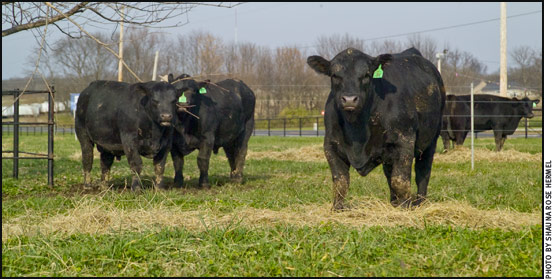HEALTH & NUTRITION...

The Law on Trich
State law on bull testing goes into effect Sept. 1.
A new state animal health law affecting movement of bulls within Missouri takes effect Sept. 1. After that, breeding bulls must be tested for trichomoniasis, or trich, before changing ownership or possession. A similar law already exists for breeding bulls coming into the state.Craig Payne, University of Missouri (MU) Extension veterinarian, explained the new rules at the MU Greenley Center Field Day at Novelty, Mo., Aug. 9. The bull-testing program aims to find and eradicate trich, a sexually transmitted disease in cow herds. Read more.
Care to Comment?
USDA seeks comments on proposed rule for animal disease traceability.
The U.S. Department of Agriculture (USDA) Animal and Plant Health Inspection Service (APHIS) issued a proposed rule Aug. 9 to establish general regulations for improving the traceability of U.S. livestock moving interstate when animal disease events take place.
"Through the past two years, I have listened carefully to stakeholders throughout the country about how to reach effective animal disease traceability in a transparent manner without additional burden," said Ag Secretary Tom Vilsack. "We are proposing a flexible approach in which states and tribes can develop systems for tracing animals that work best for them and for producers in their jurisdiction. This approach offers great flexibility at the state and local level and addresses gaps in our disease response efforts." Read more.
Time To Creep?
Scorching weather may call for creep-feeding of calves.
The oppressive heat wave that has scorched pastures and dried water sources in recent weeks should have farmers in the Northeast thinking about creep-feeding their beef calves, according to an animal scientist in Penn State's College of Agricultural Sciences.
Creep-feeding — which is simply a way to increase weaning weight by supplementing grass and milk for unweaned calves or to supplement milk production in periods of nutritional stress for cows — is a valid option now, said John Comerford, associate professor of dairy and animal science.
"However, the decision to creep-feed or not to creep-feed is a difficult one for producers," said Comerford, who coordinates Penn State's beef programs. "Like most other aspects of the beef business, it's a complex decision and one that has to be analyzed year after year.
"This management decision has lots of variables and responses that are not always predictable." Read more.

Rick Rasby
Ridin’ Herd
Nitrates in forages need to be managed during drought
Forage growing conditions across much of the United States warrant discussion on nitrates. Some forages grown under drought conditions have the potential to be high in nitrates. Understanding management practices that can mitigate the effects on beef cattle can help producers avoid a wreck. Feeds that contain nitrates can be successfully fed to cattle. Following is a discussion on management considerations when feeding feeds that contain nitrates to beef cattle. Read more.
Kindergarteners and Calves:
An Unlikely Association
Anyone who has been around a group of kindergarteners knows that sniffles and coughing are commonplace. While there may not be a way to prevent this, for weaned calves facing the same "kindergarten effect," preconditioning can help reduce morbidity.
Reducing these health challenges at such a critical growth period when commingling is frequent was the driver behind Boehringer Ingelheim Vetmedica Inc.'s (BIVI's), preconditioning program, the Range Ready® Quality Feeder Calf Program, which offers buyers assurance that calves have been given the right vaccinations when they need them.
Travis Van Anne, a professional services veterinarian with BIVI, says that developing healthy calves begins the day they are born, not just in the preconditioning phase. Read more.
Wet Weather May Lead to Unexpected Disease
Standing water may further the spread of Lepto hardjo-bovis.
After flooding and wet weather in some parts of the country, producers are anxiously looking forward to a drier fall. However, standing water may cause more than just a logistical headache for producers. The excess moisture also may help further the spread of the Lepto hardjo-bovis organism, robbing cattle of reproductive performance and producers of profitability.
Lepto hardjo-bovis is transmitted through membranes of the eyes, nose, mouth and even the skin when uninfected animals come in contact with urine of infected animals directly, or contaminated water. Read more.
Feeding Soybean Hulls to Beef Cattle
Soybeans are primarily processed for their oil, which leads to the generation of two primary byproducts: soybean meal and soybean hulls. Soybean hulls are actually the skin of the soybean, which comes off during processing. These soyhulls are quite small in size and are not very dense. Therefore, many soyhulls are pelleted to increase ease of handling and bulk density. With respect to nutritional value, the loose and pelleted hulls are equal.
Most of the time soyhulls are priced competitively to corn. In order to determine which is a better buy, we must first determine how they compare on a nutritional basis. The two nutrients that we are most interested in are energy and protein. Read more.
Dry Weather Can Lead to a Lethal Lunch
Nitrate and prussic acid buildup in forages can poison cattle.
Most people don't think of grass as poison, but dry weather and drought can turn a pasture dangerous.
Nitrates and prussic acid built to lethal levels in the stems and leaves of some plants as the hot days of July and August slowed forage growth to a halt. To protect your herd, University of Missouri (MU) Extension experts recommend a simple test to ensure cows aren't chewing their way to disaster. Read more.
Cattle Diseases: Common Conditions/Terms
Click here for a list of common conditions and terms related to beef cattle diseases, such as anaplasmosis, brucellosis, BVD, E. coli, IBR and others.
[Click here to go to the top of the page.]














